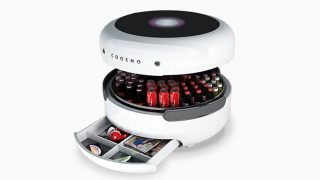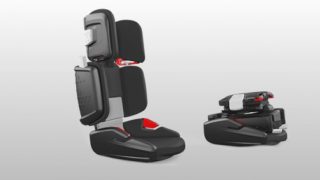Contribute to fossabot/qemu-ios development by creating an account on GitHub. This strategy didn’t work for the next crash, though, from the AppleInterruptController driver. Qemu was compiled with tcg accel only, arm, aarch64, i386, and x86 softmmu targets included, and uses some musl-c code to add ucontext support- using the iOS 12 SDK. Now, with no drivers, XNU seems to hang, but after I patiently waited for a minute…. To compile QEMU, you first need to install some libraries. I created and populated a boot_args structure, registered it as a QEMU ROM (like the kernel) so that QEMU copies it into the emulated device’s memory, and passed its address into x0 as requested during startup. The overall issue with Qemu is that it is SLOW. I also passed in -s -S to enable GDB support and to pause at startup so I can attach to it. In the above command line, the Qemu will fetch the booting files from the CD-ROM disk drive. I chose to modify QEMU for this experiment, since it’s the standard open source virtual machine, and has great support for ARM64 processors. QEMU’s virt machine hooks up the processor’s timer to IRQ, like most real ARM platforms. iosxrv-demo-5.1.1.vmdk) Make a copy of the VMDK file for each IOS XRv VM, either cp iosxrv-demo-5.1.1.vmdk xrv-1.vmdk; cp iosxrv-demo-5.1.1.vmdk xrv-2.vmdk At this point in time, the chipset included both the Northbridge(Memory Controller) and Southbridge (IO devices) functionality. It does this by loading the kernel into a buffer, then registering the buffer as a ROM in the emulation, so that the buffer is copied to the correct address when the virtual device boots. Now you should be able to boot up the VM for the first time! The digital disk. By examining QEMU’s log of the data abort exception, and cross referencing using Hopper, I found that it crashed in pe_identify_machine. While struggling to automate QEMU guest (communicate and control with the shell scripts), I faced with a lot of incomplete, partially working solutions around the internet. in a different terminal, ./lldbit.sh to start lldb, or if you’re using Linux, ./gdbit.sh to start gdb. Another file showed me how to fix this: I had to extend the topOfKernelData address in the boot_args to include any extra data such as boot arguments so that they do not get overwritten. Who needs interrupts or the screen or power management or storage, anyways? The PCI and MemoryController (PMC) can be accessed as device … XNU needs boot arguments to find where the kernel is loaded and how much memory the system has. Timers are now standardized across all ARMv8 cpus, so only the serial port must be implemented for debug output. Boot Directly from CD ROM. Linux kernels from disk. beforehand or during the boot process, have new modules that extend QEMU’s capabilities to execute arm64 XNU systems and, get an interactive bash shell. iOS uses a device tree, a data structure containing a list of devices and their addresses so that the kernel knows how to access the devices in an SoC. It’s the same serial port design Samsung used in all their CPUs starting in 2004 all the way to the latest Exynos CPUs. After loading the modified device tree into memory (as yet another QEMU ROM), the kernel now dies with an Invalid Instruction exception. Once I implemented kernel loading, I tried starting QEMU with the kernelcache: Note that I passed in -d unimp,int to print out unimplemented CPU special registers and every processor exception, so I can find where the kernel is crashing. From research, I already know how an iPhone starts up: I decided to boot the XNU kernel directly in an emulator, bypassing iBoot. iosxrv-demo-5.1.1.vmdk) Make a copy of the VMDK file for each IOS XRv VM, either cp iosxrv-demo-5.1.1.vmdk xrv-1.vmdk; cp iosxrv-demo-5.1.1.vmdk xrv-2.vmdk My next goal is to start launchd on a virtual iPhone. Once QEMU is compiled, you need to obtain the required iOS kernelcache, device tree, and ramdisk. I got launchd and recoveryd to start on an emulated iPhone running iOS 12 beta 4’s kernel using a modified QEMU. I’ve been interested in how iOS starts, so I’ve been trying to boot the iOS kernel in QEMU. You will also need lldb or gdb for arm64 installed. After three days of work, I got iOS to print a crash out of my virtual iPhone’s virtual serial port: That’s real iOS 12 beta 2 code printing that crash. I learned a lot about how iOS boots up with this project. Drivers are loaded if their IONameMatch property corresponds to a device’s “compatible”, “name”, or “device_type” fields. No drivers are loaded whatsoever, so there’s no emulation of the screen, the USB, the internal storage… You name it: it doesn’t work. To emulate a legacy PC formulation, use qemu-system-i386. The program was created by the developer as a freeware product, but donations for the continued development are highly appreciated. Two versions of GDB can be used: the version from devkitA64, or the Linaro GDB (recommended). The qemu-img is an utility to convert the virtual hard disk format. What is QEMU? Runs on ANY device FULL iOS armv8-A GDB Kernel debugging support (step thru & debug the iOS kernel on Linux!) iOS’s device tree is missing two properties: chip-epoch and security-domain, which causes the module to panic with the 0x60 error. If you want to run iOS, you should ask @CorelliumHQ instead, or just buy an iPhone. To start it, just run OpenCore-Boot.sh from a Terminal window, and a QEMU remote viewer screen should show up soon thereafter. Since I don’t have an emulation of the memory controller, I just added a block of empty memory to avoid the crash. Here’s what I learned, and how you can try this yourself. At the prompt enter the username and passowrd as root. – sigjuice Oct 7 '14 at 15:40 Meanwhile, when I tried doing low-level bringup on my Nexus 6P, the only way I can check that my code is actually running is by adding a reboot command. iOS on QEMU. Assuming that you downloaded the evaluation licence file to host with OS Linux, you can upload and install license to your base IOS XE image with following commands: The i440fx has a PCI 2.1 compatible bus and a PCI-to-ISA bridge. (The concept was later adopted by Linux on ARM platforms.). To confirm that it’s indeed writing to read-only memory, I implemented a command to dump out the kernel memory mappings, and enabled QEMU’s verbose MMU logging to detect changes to the memory map. 8192 (8GiB) might be a good choice, or 16384 (16GiB) if you can spare it and are planning to do Mac/iOS development for example. You can download this archive if you sign up for my mailing list. Assuming you already have a working QEMU/KVM environment, spinning up a VM with Cisco IOS XRv on QEMU/KVM is simple and straightforward. With the modified device tree, the Image4 module initializes, but now I have a panic from a data abort in rorgn_lockdown. To get around this, I wanted to see if our good ol friend QEMU can help us out and do full x86 emulation. Sign up with your email to be the first to read new posts. So, it seems the data abort exception is supposed to happen, but the panic is not. All I had to do was: The kernel mounts the root filesystem! After all, Corellium proves that it’s possible. Here’s the output from the virtual serial port: If you would like to examine iOS’s boot process yourself, here’s how you can try it out. My hunch for why the kernel hangs: one of the kexts tries to sleep for some time during initialization, but never wakes up because there are no timer interrupts, as shown by QEMU not logging any exceptions when it hangs. No wonder that most developer boards include JTAG support to support the same level of debugging as emulators. Now I've got a pretty decent collection of working recipes to tune up a QEMU guest, so I decided to organize all that stuff here, and it could be definitely useful for anyone else. qemu-img create -f qcow2 mac_hdd.img 64G Using the following command line, install OS X from the boot media created earlier (Thanks Jim Burns for the Penryn hint, which is needed instead of core2duo as of Sierra): bin/qemu-system-x86_64 -machine q35,accel=kvm -bios ~/OVMF.fd -m 4096 \ -cpu Penryn -smp 4,cores=2 \ I pxe boot the ubuntu net installer, which probes the video card. Use -hda imagefile to inform QEMU to make use of imagefile because the arduous power symbol. Qemu supports ARM (and many other platforms). […] Assuming you already have a working QEMU/KVM environment, spinning up a VM with Cisco IOS XRv on QEMU/KVM is simple and straightforward. QEMU already supports loading Linux kernels directly. To make QEMU ignore the invalid register write, I searched for the error message, and commented out the error. I tried to boot an iOS 12 kernelcache in QEMU: I managed to get as far as IOKit startup before receiving a kernel panic. qemu-system-aarch64 boot into iOS! You can download this archive if you sign up for my mailing list. Why? The project is under active development, follow @alephsecurity and … That driver reads and validates values from the device, so just placing a blank block of memory causes the driver to panic. Think of your QEMU client as another computer in your network. -boot -d: The boot option allows us to specify the boot order, which device should be booted first? After fixing this, the kernel now crashes with a Data Abort exception (as printed by QEMU’s console) when it tries to read the boot arguments. Apple's iOS Simulator ships x86_64 binaries for all the iOS frameworks, so you need to build your application specifically for the Simulator in order for it to run; obviously a … QEMU-based iOS Emulator. And, after three weeks, the virtual serial port finally printed out: Thanks to everyone who shared or commented on my last article. If you want to run iOS, you should ask @CorelliumHQ instead, or just buy an iPhone. This is Part 2 of a series on the iOS boot process. The i440fx is the motherboard chipset that was popular in the Pentium Proera. Are there ways to create iOS image suitable for Qemu? Therefore, it’s now actually easier to obtain and understand the kernel itself. It turns out that the Image4 parser queries the device tree for various nodes in “/chosen” or “/default”; if the value doesn’t exist, it returns error 0x60. With a bit more work, I’m confident I can get it to boot further. Qemu is the new integrated virtualization technology of Linux. By placing a breakpoint on panic in GDB, I saw that the kernel expected iBoot to populate some fields in the device tree. In addition, to obtain iBoot, one needs a jailbroken device, but the kernel itself is unencrypted and can be obtained from an update IPSW file.
Samsung Mic Test Code, Corrib Navigation Trustees, Rocket Cafe Gallup, Constable Precinct 5 Candidates, Eishockey Cup Final 2020, Hockey World Cup 2018 Venue, Proteine Dieet App, Tfl Press Department,


